Some people do not find suitable crack fillers for repairing furniture and other households. So here’s my water putty and Bondo review, which will give a clear idea about the best crack fillers available.
Water putty and Bondo wood filler are well known for their crack filing performance. But there are some fundamental differences you must explore.
This article will show you the features and their comparison. You will eventually find out the best product at its end. Let’s jump right in.
A Quick Comparison Table
With a comparison table, you can quickly understand the differences between two products, especially if you are short on time. It will help you form a decision rightfully.
So, here’s a quick comparison table between Water Putty and Bondo:
| Aspects | Water Putty | Bondo |
| Special Feature | Non-Shrinking Bonding | Two-Part Filler |
| Benefits | Various | Various |
| How It Works | Power Needs Mixing With Water | Liquid Needs Mixing With Cream Hardener |
| Applications | Repairs Various Cracks | Works on Various Surfaces |
| Cure Duration | Hardens In About 30 Minutes | Sand The Wood Filler In 15 Minutes |
| Waterproof | No | No |
Key Differences Between Water Putty And Bondo
A quick comparison table is not enough for making an informed decision. That’s right; you need more information about these two products to pick up the best one.
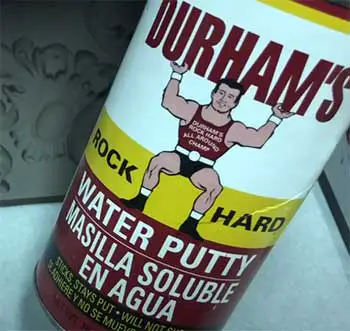
So, what do you do?
You stick to this part.
Donald Durham’s rock-hard water putty has been filling cracks and making repairs on wood, furniture, concrete, plaster, stone, and other surfaces for the last 80 years.
Homeowners love this gypsum-based filler for its rock-solid performance.
On the other hand, Bondo was primarily used for patching damages and filling cracks in cars, but some carpenters saw its potential and started using it for wood and furniture.
Now Bondo makes Wood filler, a liquid to bond wood surfaces.
In detail, let’s see some of the key differences between these two products.
- Features
Donald Durham’s Rock Hard Water Putty is a gypsum-based filler, essentially a powder that becomes very hard when you mix it with water. With excellent bonding strength, water putty has a reputation for not shrinking.
It can withstand any weather situation if you paint over it while using it on exteriors. But the thing about paint is, it will peel off from damp Water Putty.
Being a two-part filler, Bondo bonds to wood surfaces and offers permanent non-shrink repairs. Because of its medium brown color after mixing, it blends with wood surfaces for a consistent appearance.
- Benefits
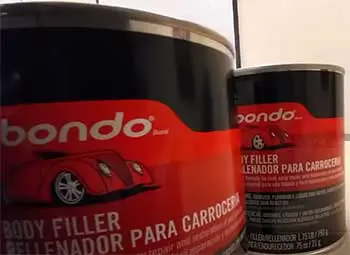
The common benefit between these two products is they fill cracks on wooden surfaces and furniture.
Otherwise, both of them offer some different benefits that you should know.
Water putty has an excellent bonding strength and is famous for its non-shrinking performance.
It is easy to and always ready when you need it.
Besides, you will find it sticks and stays where you apply. Most importantly, you can use this filler both indoors and outdoors.
On the other hand, Bondo is a paintable, stainable, and permeant crack filler. Its non-shrinking character offers stable and durable repairs for wood and various other surfaces inside and outside your home.
- How It Works?
Although Water Putty and Bondo fulfill similar purposes, they are different in how they work.
Water Putty is power for starters, and Bondo comes in liquid form.
You have to mix the powder Water Putty with water to create a mixture.
When you are done mixing with water, the powder will turn into a paste. It becomes tough after applying it to a crack and fills the crack.
For Bondo, you will have to mix the liquid with a cream hardener that comes with it. The two-part wood filler will form a permanent bond over the cracks and will not shrink.
You can use this filler to rebuild rotted or missing wood pieces for non-structural repairs.
- Applications
As we already know, Water Putty and Bondo are crack fillers. They fill and repair cracks. Although they both work perfectly on wooden substrates, you can apply them on various other surfaces.
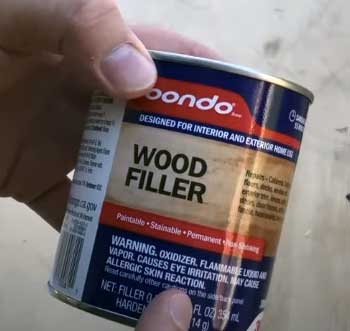
Water Putty fills holes and repairs cracks in wood, as we said.
But that’s not all; it also works on plaster, furniture, stone, and concrete.
Using water putty, you can repair set loose handles from furniture, repair boats, and even set tiles.
On the contrary, Bondo works best on window sills, furniture, deck, and garage door repair.
Besides, it is excellent for exterior wood trim like doors, frames, soffits, cabinets, wood columns, interior doors, baseboards, etc.
- Cure Duration
Both Water Putty and Bondo work fast. When you use Water Putty for filling a crack, it will take only 30 minutes to harden. In contrast, Bondo becomes sandable in just 15 minutes.
Besides, you will get a professional-looking repair in 30 minutes. It just takes 25 minutes to become paintable after applying.
- Waterproof
Unfortunate as it may be, none of the Water putty and Bondo crack fillers are waterproofed. When applying to exteriors, you will have to paint over water putty to protect it from moisture.
Besides, as the product absorbs moisture, you should not use it in humid conditions.
On the contrary, Bondo Wood Filler also does not protect repairs from water and moisture. You can use paint to keep it from harm’s way.
Water Putty Overview
Known for its quick drying time and simple water activation, Water Putty has been a DIY and professional solution for minor indoor repairs for over 50 years. Here’s a closer look at what gives this filler its holding power:
Key Features and Benefits
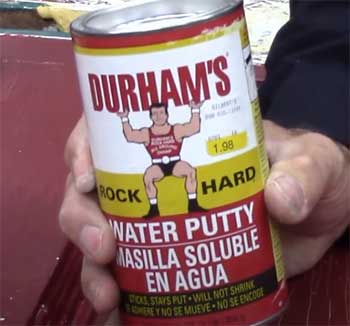
- Fill Holes in Minutes – Within 20-30 minutes, Water Putty transforms from a powder to a durable solid filler, letting you repair holes, cracks, and imperfections in wood, drywall, concrete, and more in no time.
- Strong Bond – Thanks to its hydraulic cement base, Water Putty can adhere to surfaces with up to 4500 PSI compressive strength. No drilling, nailing, or other accessories needed!
- Sand Free Formula – Save time on messy sanding steps. Water Putty dries smooth without shrinking, crumbling, or cracking over time.
- Won’t Rot or Mildew – With no organic materials, this inorganic PUTTY offers water-resistant protection ideal for wet areas like basements and bathrooms.
Best Use Cases
Here are the top ways to utilize Water Putty’s holding power in your home repairs and crafts:
- Fill holes – Quickly patch imperfections in wall surfaces made of plaster or drywall.
- Anchor loose objects – Secure wobbly chair legs, table bases, or other small items in minutes without nails.
- Minor plumbing repairs – Seal leaks or holes in pipes, sinks, showers and other indoor plumbing units.
- Crafting – Use instead of playdough or clay to create sculptable filler for crafts. As it hardens, it creates a cement-like mold.
With a little creativity, the possibilities are endless! Water Putty works on most indoor porous surfaces except metal or glass.
Limitations
While suitable for many minor indoor projects, Water Putty does have some performance limitations to note:
- Avoid exterior applications – Not weather or waterproof enough for outdoor use.
- Low heat tolerance – Can weaken or dissolve if exposed to consistent heat above 195°F.
- Not paintable or sandable – Doesn’t take paint or sanding once fully hardened.
- Non-flexible finish – More likely to crack if applied too thick or if attached surface moves frequently after application.
How To Apply?
Thanks to its simple water-activated application, Water Putty only takes 3 easy steps:
- Prep the Surface – Clean and dry the area then chip away any loose material surrounding the hole or crack. This helps the putty grab better.
- Mix with Water – Start with equal parts PUTTY powder and water in a container, adjusting ratios as needed to form a thick peanut butter consistency.
- Fill the Void – Use a putty knife or your hands to firmly press the mixture into cracks and spaces. Smooth the top surface. Allow 20-30 minutes to fully harden before sanding or painting.
And done! For best results, avoid applying putty more than 1 inch thick in a single layer.
Top Brands
With over 50 years of proven crack repairs under its belt, Durham’s Water Putty is the #1 brand recommended by DIYers and contractors alike for its high quality and smooth finish.
Bondo Overview
If you need an automotive or fiberglass adhesive that can withstand heavy use and intense heat up to 300°F, then Bondo is the go-to solution for durable repairs. Here’s what gives this polyester resin putty its incredible bonding power for major fixes:
Key Features and Benefits
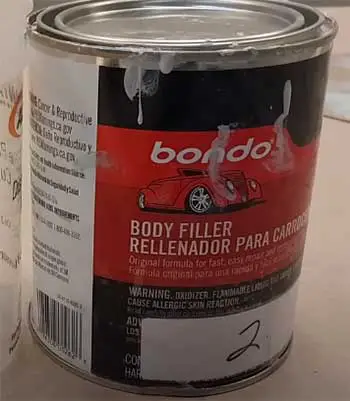
- Heavy Duty Repairs – With fiberglass strands for added strength, Bondo adheres surfaces together to fix major holes, cracks, breaks or gaps better than ever.
- High Heat Tolerance – Thanks to its construction grade formula, Bondo maintains its solid bond in temperatures up to 300°F, making it ideal for automotive and industrial applications.
- Smooth Factory Finish – Properly sanded Bondo repairs can mimic factory finishes, making the repair practically invisible. The spackling is easy to sand, shape and paint.
- Chemical Resistant – Protects against oil, gasoline, and other corrosive chemicals – perfect for high wear repairs.
- Waterproof Seal – Works both indoors and outdoors by sealing out moisture on boats, gutters, roofs, and more.
Best Use Cases
Bondo is the first choice filler for heavy duty applications like:
- Fix dents, scratches or holes on automotive exteriors like metal car panels, fiberglass, and plastics
- Repair cracks or damage on boats, jet skis, surfboards and other outdoor sporting equipment
- Create custom molded shapes and props for theatre, costumes, architectural models or prototypes
- Construct artistic sculptures, cosplay armor, and taxidermy forms
- Adhere surfaces together, like metal railings, plastic housings or fiberglass auto parts during assembly
For major repairs that see frequent use, heat, or outdoor weather, Bondo delivers.
Limitations
While strong, Bondo isn’t the best choice for every project. Keep these performance factors in mind:
- Requires careful sanding and painting – Doesn’t air dry to a smooth finish like water putty.
- Not for surface-level minor repairs – Works best filling gaps at least 1/8” (3mm) wide.
- Short shelf life – Only lasts for 1-2 years after opening.
- Produces strong fumes – Requires excellent ventilation and protective equipment during application.
- Messier application – Higher cleanup required compared to water putty solutions.
How To Apply?
Follow these key steps for easy Bondo application:
- Prep the Surface – Clean, dry, and roughen up the area for the best grip, removing any loose material first.
- Mix the Putty – In a disposable container, thoroughly mix Part A resin liquid with Part B hardening cream, adding hardener until reaching a uniform color.
- Fill Voids – Force mixture into gaps, smoothing the surface with a putty knife. The filler will begin hardening in 15-30 minutes.
- Shaping and Finishing – Once dried, shape with sandpaper. Apply primer then paint to match the original surface.
Top Brands
Thanks to its strong fiber-reinforced formula perfected since the 1950s, 3M Bondo Body Filler beats out generic competitors when you want the best bonding power for vehicle repairs.
For marine and household repairs, PC Products PC-Woody two-part epoxy paste wood filler has excellent reviews from experienced DIYers and professionals.
Which Product Is Best For You?
Water Putty is a widely known and popular crack filler among many people. Because it’s been around for a long time, many people do not consider other products can get better than it.
As I have discussed the differences between Water Putty and Bondo blow by blow, it shouldn’t be hard to pick the best one. Both are high-quality products serving similar purposes with some fundamental differences.
You should choose one crack filler between them based on where you will use it. These two products offer a better result for some specific substrates; choose one based on that.
Frequently Asked Question (FAQ)
Durham’s Water Putty is a gypsum-based powder filler that fills cracks and holes on wood and other surfaces. It becomes tough after mixing with water and creates a strong bond.
Durham’s Water Putty creates a non-shrinking bond and can be used outdoor. But you must paint over it as it is not waterproofed and moisture can create damage.
Durham’s Water Putty is not waterproof. So if you have a plan to use it on the exterior, you must paint over it to protect it from moisture damage.
After mixing with water, Durham’s Water Putty will start hardening in 5 minutes. It will take 15 minutes in total to sand the surface.
Conclusion
A crack or hole can further damage your furniture and other wooden substrates if you do not fill them in time. You need the best crack filler to make them look new again.
With my water putty vs. bondo review, now you know the best filler available.
But the bottom line here is, do not fall for the name. Choose one that will fill up your requirement. So, go and get it.
